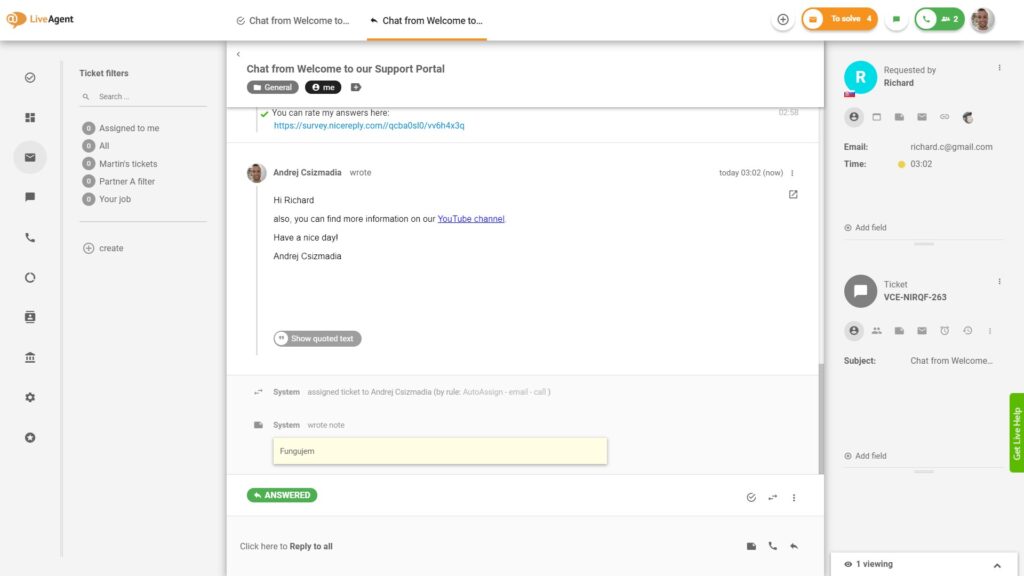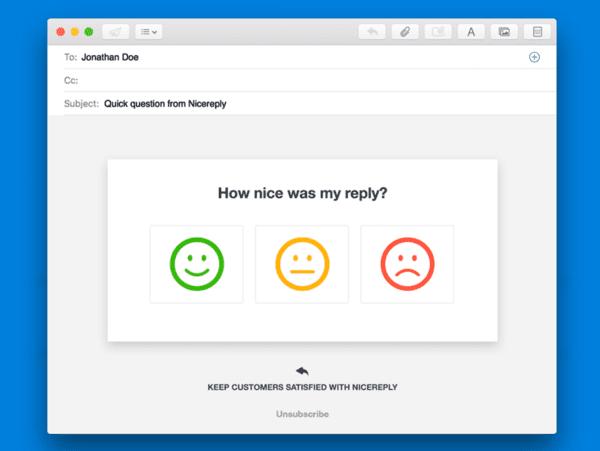- Email Templates
- Feedback request email template
Feedback request email template
Learn to use feedback request emails to engage customers and improve marketing efforts. Discover templates for gathering feedback to build meaningful connections and enhance products/services. Utilize email for valuable insights that boost customer loyalty and sales.

In today’s digital era, you must treat your customers as if they were your partners. Don’t spend too much time on small talk, listen to your clients instead! Your current and potential customers can provide you with lots of information that will help you to increase sales, generate more high-quality leads, and simply improve customer loyalty.
To do so, you can use one of the most basic and efficient communication channels – namely email.

You may think, “well, we’re already doing a good job with our email marketing.” It’s possible, but there’s always room for improvement. Why not use emails to strengthen your relationship with the contacts on your list so that they stay loyal longer and become more active? There’s a certain type of email called a feedback request email that can help you interact and build meaningful connections with potential and existing customers.
A feedback request email is a simple and creative way to engage your customers and get their feedback, which can help you improve your future marketing messages as well as your product.
What is a feedback request email? Why is it important?
Before going into detail, it is necessary to explain why gathering feedback from your customers is so important. For a long time, companies didn’t invest time or resources on getting to know their customers.
This is a mistake because asking customers about their opinions allows you to know more about the people that are willing to buy your products. As an example, this includes what their needs are and how they can be met.
Therefore, the main idea behind asking for feedback is to obtain valuable, first-hand information that will help you improve and develop your business, products, or services further.
By asking your current clients for their feedback you can find out if they are satisfied, what can be improved, and which of their needs aren’t satisfied.

Analyzing all this information and drawing smart conclusions will allow you to:
- Understand your customers. Proactively listening to your customers will allow you to get to know them better and understand them as consumers. You will be able to find out what they expect from your services and investigate their needs. It’s not just about listening to complaints or queries.
- Retain existing customers. Those who feel listened to and valued are much more likely to stay loyal to your business. Make customers feel this way by asking their opinion regularly and, whenever possible, introducing the improvements that they propose.
- Increase the loyalty of existing customers. Improving a customer’s experience by listening to and responding to their needs will help increase their level of satisfaction with your business. By increasing customer loyalty this way, you can gain brand ambassadors who will recommend your services to others.
So how should you ask your customers for feedback? By leveraging a good old email.
Examples of subject lines for feedback request email templates
- We’d love to know your opinion about [product/service]
- How did we do, [name]?
- Share your thoughts about [product/service/company]
- Thanks for purchasing [product/service]. How was your service?
- We need to talk, [name]…
- How was your experience?
- So, what do you think?
- Review your experience with [company]
- You have [amount of time] to share your thoughts about [product/service]
Feedback request email template ideas
Feedback request email template – after a joint project
Hi [name]!
I wanted to reach out to let you know that working with you on [project] has been a pleasure!
I was wondering if you’d be willing to share your thoughts on our recent project so we can get to know your opinion and act upon it.
If you want to help us improve our [product/service], follow this link [link to a feedback form] and share a few words about our project and your experience working with us.
Again, it’s been a pleasure working for you and your team.
Best,
[name & company]
“How did we do” feedback request email template
Hey [name],
How would you rate the support you received from our customer service team?
Good, I’m satisfied
Bad, I’m unsatisfied
Here’s a reminder of what your ticket was about:
[ insert ticket]
We hope we did a good job!
Best,
[name & company]
Rate products you bought feedback request email template
Hello [name],
We are constantly striving to improve, and we’d love to hear from you about the following [company] products:
Rate your [purchased product no. 1]
[a scale from 1 to 5]
Rate your [purchased product no. 2]
[a scale from 1 to 5]
Your feedback helps us improve and reach more great customers like you.
Always yours,
[company] team
Thank you for a joint project feedback request email template
Morning [name],
Thanks for your time on [date], it was great working with you, and I’m glad we could complete your project.
When we complete projects with outstanding customers, we like to finish up by asking for their opinions and suggestions about how we, [company], can improve.
If you have a few minutes, we’d love to get feedback on your experience.
Follow this link to access the feedback form [link to a feedback form].
In the meantime, please reach out if you have any questions.
Best wishes,
[name & company]
Share your thoughts via video feedback request email template
Hi [name]!
Now that you’ve had a chance to try [product/service], we’d love to know what you think about it.
Follow this link to record some video feedback [link], or simply write a review.
Tell us about the features you enjoyed, how you use [product/service], and anything else that comes to mind!
We appreciate your help.
As always, feel free to reach out if you have any questions.
Best,
[name & company]
Feedback request email template – tips & best practices to follow
Lay the foundation for sincerity
Before you start asking questions, explain how important it is for you to add value to your product or service. Tell your customers that you want to learn from their experience so that you can keep improving and ensure good service in the future.
Express your appreciation in advance and let your clients know that you understand that their time is precious, which is why you will really appreciate any feedback they share.
Ask customers what elements/features they like
The answers to this question will help you to identify all of the “good” things you are doing.
Ask customers what they would like you to eliminate
This point is crucial. It’s about asking your customers what parts of the shopping/service experience they didn’t like.
Pay special attention to these answers. If you don’t act upon advice, you will have no excuse if something similar happens again with other clients.
Ready to put our feedback request templates to use?
LiveAgent is the most reviewed and #1 rated help desk software for small to medium-sized businesses. Try it today with our free 30-day trial. No credit card required.
Frequently Asked Questions
How do you respond to a good feedback email from a customer?
When responding to a good feedback from a customer, it's important to express gratitude for the positive feedback. It's also a good opportunity to ask for permission to use the feedback for testimonials or case studies. You can also provide a discount or special offer as a token of appreciation, which can be a nice gesture to further enhance the customer's experience.
When should you send a feedback request email?
It really depends on the specifics of your product or service. Don’t wait for too long though, because your customers will probably forget about the experience they had with your company (unless it was especially negative). Sending a feedback request email up to 5 days after a purchase is a good idea.
Should I send a feedback request email even if I know that a certain client is unhappy with my product/service?
Yes, you should care about the experience of all your customers and not ignore those who have expressed a negative opinion about your product or service. Any negative feedback should be analyzed thoroughly and acted upon to help you improve your products and services.
How do you politely ask for feedback in an email template?
When asking for feedback via email in a professional setting, express gratitude first and respect the recipient's time. State clearly what feedback you need, providing necessary context, like, "I appreciate your expertise on [topic/project]; any feedback would be helpful." Specify areas you seek feedback on, explain the value of their perspective, and offer to return the favor, fostering a collaborative professional relationship.
Smart customer satisfaction software
Boost customer satisfaction in 2025 with LiveAgent! Deliver personalized, 24/7 support on every channel. Free trial, no credit card needed.
You will be
in Good Hands!
Join our community of happy clients and provide excellent customer support with LiveAgent.

Our website uses cookies. By continuing we assume your permission to deploy cookies as detailed in our privacy and cookies policy.

 Български
Български  Čeština
Čeština  Dansk
Dansk  Deutsch
Deutsch  Eesti
Eesti  Español
Español  Français
Français  Ελληνικα
Ελληνικα  Hrvatski
Hrvatski  Italiano
Italiano  Latviešu
Latviešu  Lietuviškai
Lietuviškai  Magyar
Magyar  Nederlands
Nederlands  Norsk bokmål
Norsk bokmål  Polski
Polski  Română
Română  Русский
Русский  Slovenčina
Slovenčina  Slovenščina
Slovenščina  简体中文
简体中文  Tagalog
Tagalog  Tiếng Việt
Tiếng Việt  العربية
العربية  Português
Português 


